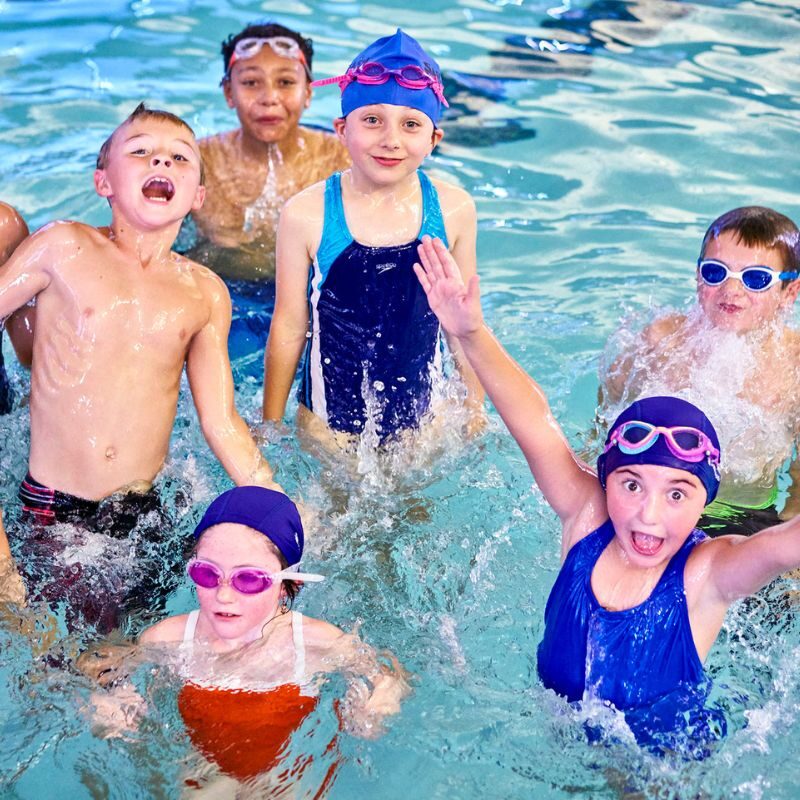Raising Safe, Confident Swimmers Isn’t a DIY Project

Learning to swim has long been considered a rite of passage in American culture, yet swimming competency rates among American kids remain surprisingly low.
The USA Swimming Foundation found that 40% of white, 45% of Hispanic, and 64% of Black kids have either no or low swimming ability. Despite that, nearly 90% of non-swimmers say they plan to visit a beach or pool at least once during the summer, putting them at significant risk of drowning. There are plenty of reasons to enroll your child in formal learn-to-swim programs — but perhaps chief among them is the fact that they reduce individual drowning risk by up to 88%.

What Does It Mean to Learn to Swim?
In the United States, drowning accidents remain one of the leading causes of death, and every year, children and adolescents account for nearly a quarter of those fatalities. As USA Swimming Foundation’s data suggests, however, drowning isn’t an equal-opportunity killer. For instance, kids with autism spectrum disorder (ASD) are 160 times more likely to drown than the general pediatric population, and Black children aged 10 to 14 are 7.6 times more likely to drown than their white peers.
With swimming season swiftly approaching, selecting the right learn-to-swim program for your kids is crucial. Huntsville, Alabama-based swim mom and business owner Kristin Stitt knows this better than most. She’s adamant that not all lessons are created equal.
“Most people think of swim lessons as a one size fits all,” says Stitt. “You hire the teenager down the street to help your kid learn the basics, and then you send them on their way.” In these do-it-yourself circumstances, swim lesson curriculum is ill-defined — if it exists at all, and a definition of swimming and competency may vary greatly. What’s more, lessons for kids 4 and under are typically focused on getting comfortable in the water and learning rudimentary skills, rather than preventing drowning.

This raises an important question: What does it truly mean to learn to swim? “Swimming is about skill and technique,” says Stitt. “Drowning prevention is more than; it requires decision-making ability, experience in the water, and straight-up education, awareness and supervision”. Failing to consider all of those elements results in a false sense of security that could put your child at an even greater risk of drowning.
Studies show that parents often overestimate their child’s swimming abilities, and once kids are in lessons, that confidence grows, causing parents to underestimate water supervision needs.
Those who’ve experienced the tragedy of losing or nearly losing a child to drowning will be the first to tell you: Drowning is a silent, quick killer. There are rarely cries for help or splashes to alert adults to the issue, which explains why one study found that just 12% of preschool-aged drownings are actually witnessed. Sadly, most kids drown near caretakers who just aren’t paying close enough attention.
Filling a Community Need
Last year, Stitt, who has a background in healthcare leadership, started examining gaps in learn-to-swim programs in her own community. After researching swim school franchises around the country, she decided to invest in SafeSplash, an organization that not only shared her vision, but also had the infrastructure to bring it to life.
“I didn’t just want evidence-based curriculum for the students — I also wanted a proven method for training instructors so delivery of the curriculum would be effective and standardized,” says Stitt. “Just because someone knows how to swim doesn’t automatically mean they know how to teach that skill.”

To help realize that mission, Stitt tapped seasoned competitive swimmer Dylan Eichberg as VP of Aquatic Operations. During his college career, Eichberg swam for Virginia Tech, where he earned a title as an NCAA All-American in the 200 Butterfly, but his swimming origin story has humbler roots. “I had a lot of energy as a kid,” says Eichberg with a chuckle. “At 6, my parents enrolled me in swim lessons for a year before sticking me in a summer league.”
Later, he went on to join the summer league’s coaching staff, mainly working with kids 8 and under. “I loved working with the young kids because it was so fulfilling to see their skills progress,” said Eichberg.
“With SafeSplash, I’m seeing that development through more of a safety lens, and that honestly makes me love it even more.”
Safe Swimming for All
Eichberg found that structure makes all the difference when it comes to learn-to-swim programs, and he’s quick to credit SafeSplash’s curriculum, which was developed and vetted by industry professionals.
“I used to be that person giving backyard lessons, and this is way better,” says Eichberg. “I did the best I could, but I didn’t have the language to break down my swimming knowledge into bite-sized chunks that students could easily absorb and implement.”
In contrast, the school’s teaching approach is designed to teach swimmers as early as 6 months old the building blocks of safe, confident swimming by progressing through a series of standardized lesson plans. Instructors utilize skill checklists to document progress as students move through the 12 unique teaching levels.

“When I saw the curriculum for SafeSplash, the step-by-step process of learning to swim felt so much more digestible,” says Eichberg. “It made it easy to teach just about anyone.” And teach just about anyone they do! SafeSplash accepts students of all ages, skill levels, and abilities, from 6 months to adults. “Some kids come in barely able to put their face in the water, while others participate in summer swim leagues and just want to grow their existing skills base,” says Eichberg.
SafeSplash also offers an Adaptive Aquatics program that gives kids with special abilities the opportunity to learn to swim. “Our adaptive program is personalized for people of all abilities, including neurodivergent individuals as well as anyone with muscular dystrophy or Down syndrome, for instance,” says Eichberg.
With the spring season already underway, Memorial Day Weekend 2023 will be here before we know it. Teaching your kids the building blocks of water safety is more important than ever, and it starts by selecting a comprehensive program that works for your individual child. Rather than hire the kid down the street or take on the task yourself, place your trust in a swim instruction program with trained instructors and a consistent, structured, and evidence-based curriculum.
Connect with SafeSplash Swim School
Phone: 256-257-5596
Jones Valley Location
Madison Location
You Might Also Like…
Rocket City Mom is a website about raising children in and around Huntsville, Alabama. Started in late 2010 by a local mom and newcomer to Huntsville, Rocket City Mom has grown into a thriving community of local parents and now boasts a staff of four, thirteen regular contributors, and tens of thousands of Tennessee Valley readers making it the #1 Parenting Resource in North Alabama.






